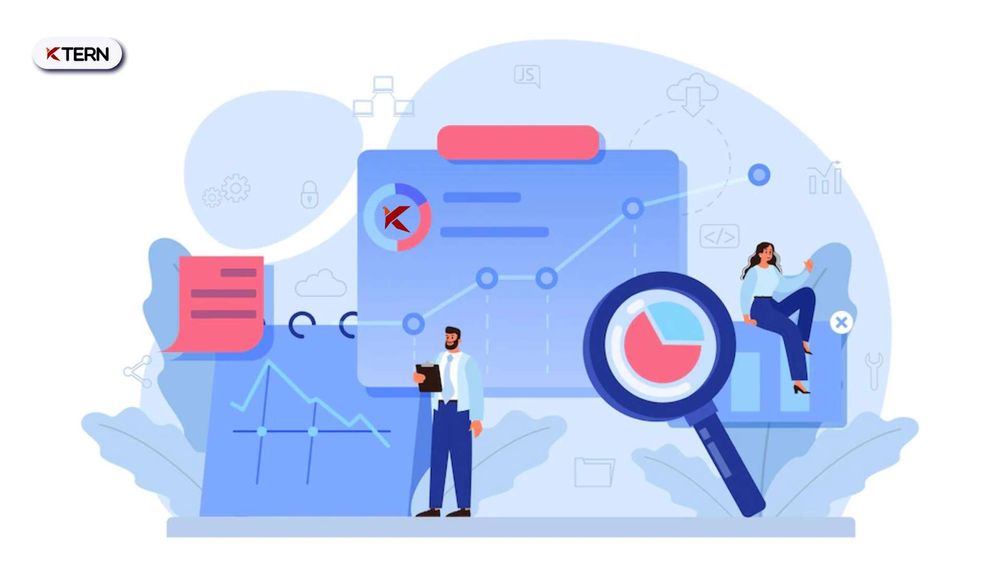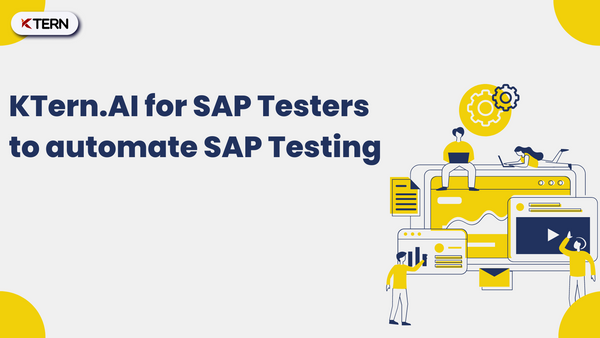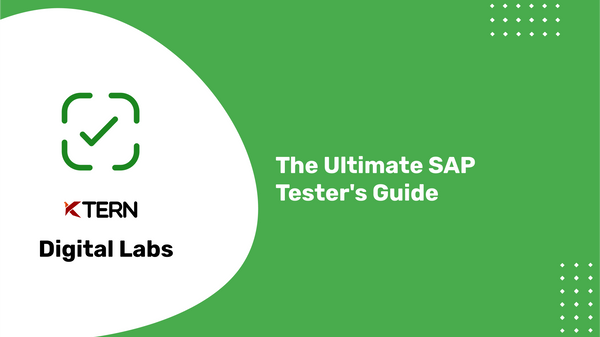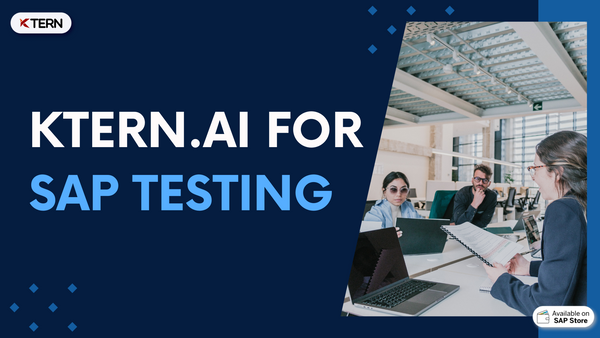The Beginner’s Guide to SAP S/4HANA 2022 Testing using KTern
SAP launched R/3 way back in 1992 and has since come a long way to the modern-day ERP, SAP S/4HANA. It is the next-generation ERP suite powered by the HANA database and it impacts every nook and corner of the business. Apart from the data definition changes, the most significant change in SAP S/4HANA has been the user experience using Fiori applications. It delivers a role-based user experience across all lines of business, tasks and devices.
But, what do you think is the one major constant across all these extensive software upgrades? Yes, the one common process is SAP Testing. Testing is mandatory and critical for every single upgrade project, more so for an SAP ECC to SAP S/4HANA migration project because there is a major change in how a user experiences S/4HANA.
Table of contents
- Introduction
- Overview of SAP S/4HANA
- What is SAP Testing?
- Problems in SAP S/4HANA Testing
- Types of Testing in SAP
- Introduction to KTern's Digital Labs
- Test Suite Cockpit
- Test Case Wizard
- Test Suite Dashboard
- How is KTern’s Digital Labs different from that of its competitors?
- Next Steps
Introduction
SAP testing is the process of testing SAP software applications to ensure that they meet the requirements and are working as expected. It involves testing the functionality, performance, security, and usability of SAP applications to ensure that they meet the needs of the business and end-users.
SAP testing is a critical part of any SAP implementation project, as it helps to identify defects and issues early in the project lifecycle, reducing the risk of delays and cost overruns. It involves a range of testing techniques, including unit testing, integration testing, system testing, regression testing, and user acceptance testing.

Overview of SAP S/4HANA
SAP S/4HANA is a real-time, in-memory, columnar database platform that is designed to run on-premise, in the cloud, or in a hybrid deployment. It offers a simplified data model that eliminates redundant data storage and reduces the complexity of the system. This results in faster data processing and more efficient use of hardware resources.
SAP S/4HANA offers a range of capabilities that support various business processes such as finance, sales, procurement, production, and supply chain management. It also includes advanced analytics and reporting tools that enable users to gain insights into their business operations in real-time.
SAP S/4HANA has a user-friendly interface that enables users to access the system from anywhere, on any device, and at any time. It also offers integration with other SAP products, such as SAP Ariba, SAP SuccessFactors, and SAP Concur, to provide a seamless end-to-end experience.
What is SAP Testing?
An SAP system undergoes enhancements in functionality and certain fixes through upgrades. SAP testing is the process of verifying the functioning of these changes with an intent to find out whether the ERP system meets the specified requirements. In other words, testing is essentially a quality assurance process.

But, an SAP S/4HANA migration is not any mere technical upgrade. It impacts functionalities and business processes as well. It also comes with regular releases and upgrades. Hence, testing becomes all the more crucial. Organizations must build, test and deploy S/4HANA solutions continuously, in order to extract full business value out of it.
Problems in SAP S/4HANA Testing
In today’s digital world, SAP S/4HANA testing remains a great area of concern for both the business users and the business decision-makers. According to statistics, over 72% of the organizations rely on manual SAP testing. Manual testing not only consumes 30% of the total project cost, but is also time-consuming and inaccurate at times.
Following are some of the major problems in S/4HANA testing:
- Poor documentation of testers
- Low degree of test automation
- Maintaining test audits
- Cost-benefit analysis of testing
As per SAP’s Activate framework, the SAP testing methodology or the test lifecycle consists of three phases:
- Test Planning
- Test Preparation and Execution
- Test Validation
However, there are several SAP test automation tools available in the market today to automate the manual testing process. In this article, we will explain how KTern’s Digital Labs can help you across each of the above phases and effortlessly detect the impact of change while moving to S/4HANA.
Types of Testing in SAP
- Unit testing
- System testing
- String testing
- Integration testing
- Interface testing
- User Acceptance testing/ End User testing
- Stress/Performance testing
- Security and Authorizations testing
- Cutover testing
- Regression testing
Introduction to KTern's Digital Labs
KTern.AI is an automated digital workplace for SAP Digital Transformations. With decades worth of SAP Tribal knowledge combined with automation, governance and collaboration capabilities, KTern is built to help the existing ECC customers migrate to S/4HANA. KTern covers the entire lifecycle and guides you before, during and after the conversion. Its inbuilt S/4HANAPEDIA rule engine combined with several modules eases the transition from SAP ECC to SAP S/4HANA.
Digital Labs of KTern is tightly integrated with Digital Projects hub, which is the project management suite. Typically, the testers would be testing the various test cases on one side and the governance would take place via emails or chat or any other project management tool. The whole process was cumbersome and arduous for all the stakeholders involved. Therefore, we developed Digital Labs of KTern to execute, manage and collaborate all the testing related activities of an S/4HANA migration/upgrade project from a single place.
KTern strictly abides by SAP’s Activate framework. Hence, as the first step, in the Discover phase, KTern completely analyses the entire ECC landscape and auto-recommends the test cases and test scenarios. Based on the number of test cases and complexity of the system, KTern calculates the effort and timeline for the S/4HANA migration project.
Test Suite Cockpit
Upon launching the Digital Labs of KTern, you will be taken to the Test Suite Cockpit. It contains three sub-sections: Test Catalog, Auto Recommendations and Auto Import. It also includes the Test Suite Dashboard and the Sign-Off Wizard.
Test Catalog
The test catalog contains the universal list of all the test plans, test scenarios and test cases. It acts as a launchpad from where you can execute the various test cases. The Test Catalog contains the test plans, test scenarios, and the test cases in a hierarchical manner. Each plan can have “n” scenarios under it which in turn can contain “n” test cases. Each of the plan, scenario and test case has a description, related module, testing type and priority assigned adjacent to it.

In addition, you can also create new test plans, test scenarios under test plan and test cases linked to test scenarios in KTern. While creating them, you can assign the modules to which they belong, the type of testing, priority and stakeholders as well. The workflow management is taken care by KTern while we perform any action on the test case, thereby enhancing the collaboration among the project stakeholders.

Auto Recommendations
KTern’s Auto Recommendation feature connects to any SAP system, analyzes the system comprehensively and generates the Test Case Recommendations for a digital transformation project. This is usually done in the Discover phase. The test cases are generated based on the usage log and business data in the system. The priority of the test cases is automatically assigned based on the Value, Volume and Velocity Analysis (VVV scoring). You can then select and import all these test cases to the Test Catalog. KTern also provides the option of editing these test cases either individually or in bulk.

Auto Import
In case you have been maintaining all your test cases in an excel sheet, KTern also provides an option of importing these test cases via the Auto Import function. Thus, you need not create each and every test plan, test scenario and test case manually inside KTern.
Test Case Wizard
Once you click and launch any test case from the test catalog, you will be automatically directed to the Test Case Wizard. The test case wizard consists of some basic information like the status, priority and the test type. It also has the option of editing the test case.
Test Center
Under the test case wizard is the Test Center. It is the one-stop center for getting all the information, notes and files with respect to a test case. Some of the important details in the Test Center provides the following info regarding a test case:
- Test plan and scenario to which the test case belongs
- Related functional module of the test case
- Business Process of the test case
- Description of the test case
- Materiality profiling score of the test case
- Stakeholders involved in that particular test case
- Planned vs Actual details of the test case
- Any files uploaded by a team member against that test case
- A discussion forum for stakeholders to collaborate
- A platform for any reference or wiki notes
- The test case/work-item hierarchy tracker
As you can see, the test center in KTern acts as an intuitive platform to collaborate and get things done. Instead for multiple email threads and project governance tools, you can simply login to KTern and perform all the activities instantaneously. In this way, KTern offers a higher visibility to the project managers and key stakeholders on all testing activities.

Test Lab
Test script and Test evidences are almost synonymous with executing a test case. A test script is nothing but a set of instructions that defines the steps to be executed along with the expected results for each step. The Test Lab of KTern allows you to create test scripts and test execution logs. You can define the environment in which the test case must be executed and also the various steps and expected results of the test script.

Rigorous testing requires tracking of what was done and what was observed. Test evidence enables you to record the results of the test execution. In case of any issues during the test case execution, corresponding defects can also be captured against a test evidence.

Auto Test Console
Auto Test Console in KTern enables you to perform auto test case executions. You just have to connect the SAP system to KTern and click on the “Perform Auto Execution” button.

After auto-executing the test case, KTern automatically creates the test evidence and records the outcome of the test case execution.
Defects Repository
There is a separate defects repository in the test case wizard from where you can create issues/defects related to the test cases. A defect is primarily created when a test case execution has failed. While creating a defect, you can assign stakeholders, planned vs actual dates and map the created defect to a particular test case. Therefore, in this way, KTern provides a way for all the project managers, test engineers and key stakeholders to operate from one place and one place only.
KTern also captures the history thereby enabling you to track all the changes which have been made to that test case since it was created.
In addition, you can also download an auto-generated test case report which contains all the details of the test case. If need arises, you can also edit the test case report.

Test Suite Dashboard
VVV Analysis
The VVV Scoring Dashboard covers the Value, Velocity, and Volume Analysis of the business per transaction usage. There could be ‘n’ number of business processes in a system. This dashboard identifies the critical business processes and prioritizes the test cases which must be tested based on the following factors:
- Value - This score denotes the merit and significance of the transactional execution for the business scenario.
- Volume - This score denotes the magnitude of the data and documents obtained from the transactional execution of the business scenario.
- Velocity - This score denotes the frequency of the transactional execution for the corresponding business scenario.
KTern automatically analyses each transaction based on its value, volume and velocity and assigns a score between 1 and 10. Based on the VVV scores, KTern derives the materiality score for the business processes.
The Materiality Score signifies the overall business value derived for the respective transaction. Higher the score, higher is the relevancy of the business process and vice versa. While auto-generating the test case recommendations, KTern assigns the priority of each test case based on this VVV-based materiality score.
Since testing is a very manual effort, there are chances that execution of certain test cases might be skipped with time as a factor. In such cases, KTern dashboard enables the project managers and test managers to prioritize the most significant test cases for testing and not miss out on any critical test case. This ensures that all the critical business processes are tested before going live with the production environment, thereby enabling a smooth transition to S/4HANA.

Status of work items
In KTern Dashboard, you can also find the breakdown of test cases and defects by status. It gives a graphical representation of the new, active, performed and approved test cases/defects. It also represents the split of these work items by modules, business process and type of testing.

Resource Utilization Table
This table provides an overview of all the stakeholders and testers involved in the project. It has a list of all the testers working in the project along with the number of test cases allocated to them. It also tracks the progress of each stakeholder with respect to test case execution.
Thus, the test suite dashboard becomes the one dashboard using which the project manager can monitor all the test cases and progress of testing process as a whole, in the project.

Test Suite Sign-Off wizard
Testing is one aspect of S/4HANA migration which can extend the timeline of the project since it involves a lot of ambiguity. No matter how well you document a test case and raise defects, there’s always some sort of difference or ambiguity between the system integrator and the customer. KTern’s sign-off wizard provides a way to ensure transparency among the key decision makers.
KTern allows you to create multiple sign-off items and map multiple test cases under each sign-off item. The respective stakeholders can approve these sign-off items hierarchically. There is one root node from which sign-off items can be created for each scenario and sub-scenario. Then, the testers, test-engineers, department heads, project managers and project champions from both the system integrator side and the customer side can approve these sign-off items. This ensures complete visibility and transparency. Also, there will be fewer problems during cut-over orchestration.

How is KTern’s Digital Labs different from that of its competitors?
There are several SAP testing tools available in the market like HP ALM and Tricentis Tosca. They are used in the actual testing during the Realize phase of a S/4HANA conversion.
However, the differentiating factor of KTern is that it enables us to automate, managing and monitoring the testing process analysis starting from the Discover phase itself. In addition, KTern provides a detailed of each test case and the materiality score formulated helps in prioritization of test execution. All this results in better decision making and planning during your journey to S/4HANA.
Challenges in SAP Testing Explained
Another differentiating factor of KTern is the tight integration between Digital Labs and Digital Projects (the project management hub). A Digital Transformation project is not dependent only on data and process flows alone. One of the critical factors for the success of any digital transformation is the active collaboration of stakeholders. The same holds true for an S/4HANA conversion project, which forms the core of your digital enterprise. In this sense, KTern provides a completely wholesome experience for all the stakeholders involved in the project.
Next Steps
Now that you know how KTern performs custom code remediation, you might want to get a first-hand feel of KTern and its other several other modules which help automate and govern SAP projects from start to finish. You can get started with the same at Getting Started . Alternatively, if you would like a guided demo of the product from one of our product engineers, kindly get in touch with us by submitting a message at Contact Us.




